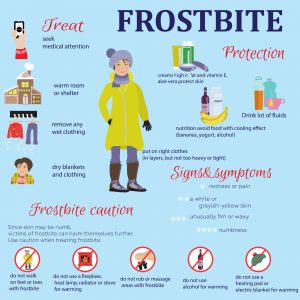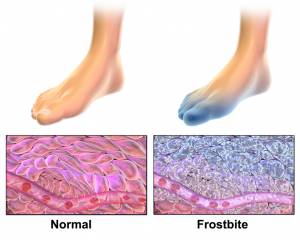
Frostbite
With the bomb cyclone and severe winter temperatures over the weekend, frostbite is definitely something to worry about. But what exactly is frostbite? Here we discuss frostbite symptoms, prevention measures and how to treat frostbite.
How are frostbite symptoms different from other cold weather injuries?
Chilblains
 Frostbite is the most severe type of cold weather injury. However, milder cold weather injuries sometimes are mistaken for frostbite. Chilblains is a milder form, usually found in females when the skin has been exposed to cold, wet, and windy weather conditions. It can cause red, dry, rough, swollen skin and little red bumps may form that can ulcerate. When I see patients with these symptoms, they usually remain throughout the cold weather, and then they resolve with the return of warm weather. I generally tell patients to keep warm layers on and apply lotion to protect the skin from becoming rough and dry. I see this a lot in skiers.
Frostbite is the most severe type of cold weather injury. However, milder cold weather injuries sometimes are mistaken for frostbite. Chilblains is a milder form, usually found in females when the skin has been exposed to cold, wet, and windy weather conditions. It can cause red, dry, rough, swollen skin and little red bumps may form that can ulcerate. When I see patients with these symptoms, they usually remain throughout the cold weather, and then they resolve with the return of warm weather. I generally tell patients to keep warm layers on and apply lotion to protect the skin from becoming rough and dry. I see this a lot in skiers.
Trench foot
Trench foot is another cold weather condition that can be found in people in the military, hunters, and fishermen. It can be found when these people have been in cold, wet environments for a prolonged amount of time, usually over 10 hours. Their skin temperatures are usually lower, and their feet may appear white, swollen, or bluish. They may have blisters, and they can develop permanent sensitivity to cold, even after their feet are rewarmed.
Frostbite
Frostbite, which is the most severe type of cold injury, occurs when the tissues freeze. It can happen when the feet are cold and wet. It may be associated with hypothermia, which is when the body temperature falls below 95 degrees F. Symptoms include changes in skin color from white to red to blue, numbness, burning, blisters, swelling, or a rubbery, waxy appearance. It can be classified into different stages depending on the extent of tissue damage, which is similar to classifying burns. First degree is considered mild frostbite and is associated with the skin becoming red and irritated. Second degree is characterized by blisters and swelling, but there is no major tissue damage. Third degree, the most severe, involves all skin layers and lead to permanent damage through the skin and underlying tissue layers.
Frostbite Prevention
Wear insulated clothing and dress in layers. It is important to wear warm socks, and I recommended wearing two pairs. Choose an inner layer made of a synthetic fiber (not cotton, which is absorbent) because it will wick water away from the skin. Wool is the best material for the outer layer of socks to increase insulation. Shoes or boots should be waterproof and insulated. Cover all areas of exposed skin at all times. Clothes should not be tight or constricting, and they should be loose enough to allow for mobility. Always travel with a friend so help can be provided if needed. Avoid smoking, alcohol, or caffeine. Take extra precautions in wet, windy conditions, because wind chill can make the air temperature lower. Elderly people, babies, and those with peripheral vascular disease, diabetes, renal failure are more at risk for frostbite. They will need to be extra careful.
Frostbite Treatment
If you think you may have frostbite, it is important to seek medical help. First make sure that you are not experiencing hypothermia. This condition is life threatening and needs immediate attention. In order to keep swelling down, keeping the feet elevated is important. Stay in a warm area to keep heat loss minimal, and avoid walking on frostbitten toes or feet. It is important to avoid alcohol and caffeine to prevent the vessels from constricting, and remove anything wet or constrictive that may prevent blood flow to the toes. Apply a sterile bandage to the toes involved or cotton to prevent rubbing. Also, never rewarm the frostbitten area if there is a chance it could freeze again. Thawing and re-freezing leads to very harmful outcomes. If there is no chance of re-freezing, warm the affected feet or toes in water that is not too hot. Warming as soon as possible is important to stop the damage from worsening.
It is important to note that you may not actually feel frostbite setting in. So if you’re spending any time outdoors in the winter, it is important to be aware of the danger. Take precautions when choosing footwear and clothing. Don’t underestimate the warning signs, and seek medical attention if you believe you may be experiencing any frostbite symptoms. As always, please contact us if you have any questions of concerns. We are more than happy to help.
